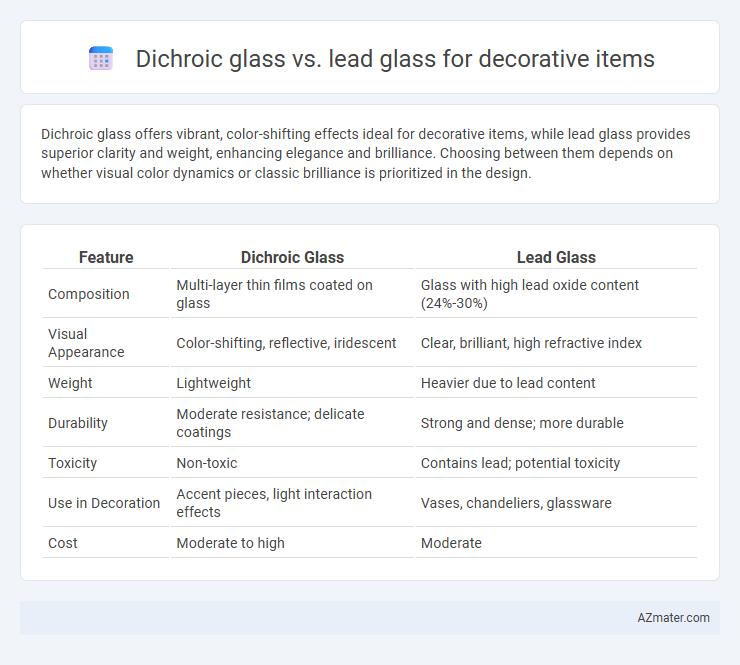Dichroic glass offers vibrant, color-shifting effects ideal for decorative items, while lead glass provides superior clarity and weight, enhancing elegance and brilliance. Choosing between them depends on whether visual color dynamics or classic brilliance is prioritized in the design.
Table of Comparison
| Feature | Dichroic Glass | Lead Glass |
|---|---|---|
| Composition | Multi-layer thin films coated on glass | Glass with high lead oxide content (24%-30%) |
| Visual Appearance | Color-shifting, reflective, iridescent | Clear, brilliant, high refractive index |
| Weight | Lightweight | Heavier due to lead content |
| Durability | Moderate resistance; delicate coatings | Strong and dense; more durable |
| Toxicity | Non-toxic | Contains lead; potential toxicity |
| Use in Decoration | Accent pieces, light interaction effects | Vases, chandeliers, glassware |
| Cost | Moderate to high | Moderate |
Introduction to Dichroic and Lead Glass
Dichroic glass is a specialty glass containing multiple micro-layers of metal oxides that create a unique, color-shifting effect through light interference, often used in high-end decorative items and jewelry. Lead glass, also known as crystal glass, contains lead oxide that enhances its clarity, brilliance, and weight, making it popular for ornate decorative pieces and fine glassware. While dichroic glass is valued for its dynamic, iridescent appearance, lead glass is prized for its elegance and refraction qualities in decorative art.
What is Dichroic Glass?
Dichroic glass is a multi-layered glass coated with micro-layers of metal oxides that reflect and transmit specific wavelengths of light, creating vibrant color shifts and a shimmering effect ideal for decorative items. Unlike lead glass, which relies on lead oxide to enhance density and refractive properties, dichroic glass offers enhanced optical performance with durability and unique color dynamics. This makes dichroic glass highly favored in modern decorative arts for its iridescence and light-responsive aesthetic.
What is Lead Glass?
Lead glass, also known as crystal glass, contains a significant percentage of lead oxide, typically between 18% and 40%, which enhances its refractive index and weight, creating a brilliant sparkle ideal for decorative items. Its dense composition allows for greater clarity and brilliance, making it a popular choice for fine glassware, chandeliers, and ornamental pieces. Unlike dichroic glass, which features a multi-layered coating that produces color-changing effects, lead glass emphasizes clarity and light refraction for a classic, elegant appearance.
Visual Appeal: Color and Light Effects
Dichroic glass exhibits a unique visual appeal through its vibrant, shifting colors and iridescent light effects caused by multiple micro-layers of metal oxides, creating dynamic reflections that change with the viewing angle. Lead glass, known for its high clarity and brilliance, offers a classic, sparkling appearance with enhanced refraction and dispersion of light, resulting in rich, clear tones and dazzling highlights. While dichroic glass provides a contemporary, color-shifting aesthetic ideal for modern decorative pieces, lead glass excels in delivering timeless elegance with vivid light play and deep color saturation.
Durability and Maintenance Comparison
Dichroic glass offers superior durability due to its multi-layered coating that resists scratches and fading, making it ideal for long-lasting decorative items. Lead glass, while prized for its brilliance and clarity, is softer and more prone to damage, requiring careful handling and regular maintenance to prevent scratches and wear. Maintenance for dichroic glass is minimal as it resists tarnishing, whereas lead glass demands gentle cleaning methods to preserve its appearance over time.
Safety Considerations for Decorative Usage
Dichroic glass offers enhanced safety for decorative items due to its non-toxic composition and resistance to chipping, reducing risks in households and public spaces. Lead glass, containing elevated levels of lead oxide, poses potential health hazards, especially if damaged or used in environments with frequent handling, as lead exposure can be harmful. For decorative usage, dichroic glass is preferable in settings prioritizing safety, whereas lead glass requires careful placement to minimize health risks.
Artistic Versatility and Applications
Dichroic glass offers unparalleled artistic versatility due to its multi-layer optical coatings, producing vibrant color shifts and dynamic reflections ideal for contemporary decorative items, jewelry, and lighting designs. Lead glass, known for its high refractive index and clarity, excels in traditional applications such as fine crystal ware, sculptures, and ornamental pieces where brilliance and weight are prized. While dichroic glass emphasizes color play and modern aesthetics, lead glass remains favored for classic elegance and intricate craftsmanship in decorative art.
Cost and Availability
Dichroic glass, known for its vibrant color-shifting properties, typically incurs higher production costs due to specialized coating processes, making it less widely available and more expensive than lead glass. Lead glass, often used in decorative items for its clarity and brilliance, is more readily available and cost-effective, benefiting from established manufacturing techniques and abundant raw materials. Consumers seeking unique optical effects may opt for dichroic glass despite the premium price, while budget-conscious buyers favor lead glass for affordable elegance.
Environmental Impact
Dichroic glass features a metal oxide coating that is durable, non-toxic, and recyclable, resulting in a lower environmental footprint compared to lead glass, which contains hazardous lead compounds that pose significant health and ecological risks during production and disposal. Lead glass requires careful handling and specialized waste management due to its toxicity and potential soil and water contamination. Choosing dichroic glass promotes safer manufacturing processes and end-of-life recyclability, reducing environmental pollution and supporting sustainable decorative item production.
Which Glass is Best for Decorative Items?
Dichroic glass offers vibrant color shifts and high durability, making it ideal for decorative items requiring dynamic visual effects and longevity. Lead glass provides excellent clarity and weight, enhancing the elegance and brilliance of ornaments but is more prone to damage and less colorful than dichroic glass. For decorative items that prioritize vivid aesthetics and durability, dichroic glass is often the superior choice.

Infographic: Dichroic glass vs Lead glass for Decorative item
 azmater.com
azmater.com